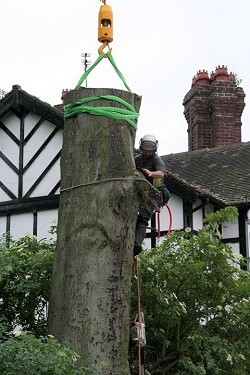Tree Surgeon fells Beech in Alexandra Park, Edgeley, Stockport
 During the course of our work as Stockport’s tree surgeons, Myers Tree Care was awarded a contract by Stockport Metropolitan Borough Council to fell this monster of a tree in Alexandra Park, Edgeley.
During the course of our work as Stockport’s tree surgeons, Myers Tree Care was awarded a contract by Stockport Metropolitan Borough Council to fell this monster of a tree in Alexandra Park, Edgeley.
The council had condemned the mature Beech as it had a severe root infection. We began by organising and creating a method statement identifying the best tree felling techniques for removal, with public safety being of paramount importance.
The condemned tree was located at the edge of Alexandra Park and was very close to a bordering property and a busy road. During the initial site visit, we had taken a series of photos of the surroundings and after studying the site conditions carefully, and with a tight timeframe to complete the tree work, we decided to use a mobile crane to assist in the precise removal of this large tree.
If our tree surgeons had undertaken this sectional felling operation using the conventional methods for removing a tree of this size, the time to carry out the work would have been at least two days and involved prolonged disruption to the local area and residents.
Not to mention far more labour time from our tree care operatives.
When using a crane during sectional tree felling much larger sections can be removed and placed on the ground without the need for lowering devices, ropes or sheer effort to convert, drag and process the arisings. Each section to be lifted can vary in weight from a few pounds to upwards of four tons plus, depending on the crane’s lifting capabilities and reach.
Stockport’s Alexandra Park in Edgeley sees Myers Tree Care sectional fell monster tree
On the day of the work, our tree care team arrived and placed the wood chipper and vehicles within the park on one of the pathways. The crane arrived at 8.30 am and when the operator was happy with his position he promptly set his out-riggers and our tree care operatives completed securing the work area.
At this point, the tree surgeon climber had accessed the tree, attached his climbing line and selected his first section to be cut. The crane operator positioned his jib over the lift and then lowered his hook for connection with the sling. Once connected the tension was set and the tree surgeon commenced cutting and the first section was lifted clear and set down in the processing area by the ground staff.
The tree surgeon/climber had radio contact at all times with a dedicated member of the team, who liaised with the crane operator to confirm the weight that could be lifted on each cycle and so that the climber could also instruct the operator where he would like the hook to be placed for the next section to be removed.
Once the canopy had been removed the cut sections got heavier as the operator could lower his jib and the reduced reach meant the crane was capable of lifting heavier sections.
The lifting slings had a certified loading of two tons so the climber employed two slings for the lower sections of the trunk to ensure these limits were not exceeded. Using two slings is also helpful to ensure that the cut sections are balanced and there is more control as they are lifted.
The last section to be removed weighed just under 4 tons and, as can be seen in the photos, was within 8” of a listed wall on one side and iron railings on the other side at the same distance. With this in mind, we had to ensure a ‘square lift’ was employed for this last section as any sideways movement would have destroyed either the wall or railings and this would not be acceptable.
All the larger timber sections were placed on the highway for loading onto our crane wagon; these pieces were then transported to Woodbank Park in Offerton, Stockport, for conversion into benches at a later date. The remaining timber that was within the park was then lifted out and again placed on the road for collection and removal from site. All the woodchip arisings were tipped in the council yard within the park for use later in the year.
From start to finish the whole job took just 6 hours with four operatives (plus the crane operator) proving that the use of cranes really does improve safety and performance and slashes the time that it would normally take to complete the same operation using conventional sectional felling methods.

















